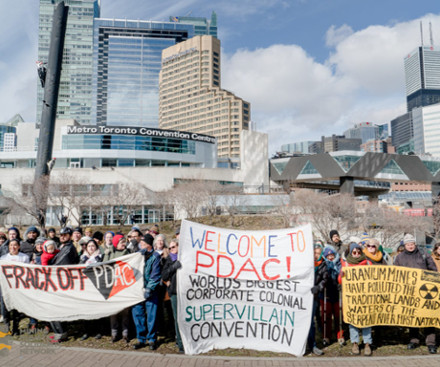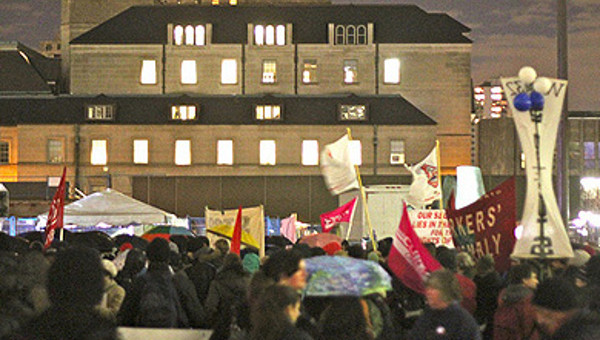On Sunday March 5th, the Prospectors and Developers Association of Canada (PDAC) hosted its 85th annual conference in downtown Toronto. With more than 20,000 attendees and 900 exhibitors, the conference is the largest of its kind in the world. During those four days, delegates take over 20 of Toronto’s downtown hotels and spend millions of dollars in its restaurants and bars.

The most striking find came from the booth of the U.S. Geological Survey, whose material was entirely about extractive prospects in Afghanistan. A message on the back of the reports expressed appreciation for the generous support of both USAid and the Department of Defence.
Massive Profits, Unspeakable Harm
The next evening in post-conference drinks at the Royal York hotel, I met a young woman who had spent the previous summer prospecting a gold formation in north-western Ontario. When I asked how much her company expected to sell it for, she shrugged and said, without smugness or irony: “Probably for hundreds of millions of dollars.”
On the third day, I left the conference to visit an aboriginal community centre in the east end of Toronto. A lecture was being delivered by a Mayan Q’eqchi’ woman from eastern Guatemala named Angelica Choc, who had initiated a lawsuit against Toronto-based Hudbay Minerals in the Ontario Superior Court.
Choc was suing the company for atrocities allegedly committed between 2007 and 2009, a time when the Canadian mining company Skye Resources was attempting to begin extraction at the Fenix mine, the largest repository of nickel in Central America. Choc says the company was attempting to displace the neighbouring Q’eqchi’ villagers from their land, and that security guards hired by the company reportedly committed multiple atrocities against the indigenous Mayan community. In 2011, she and 12 others in her community filed a civil lawsuit in Canadian courts against Skye, which has since been acquired by Hudbay; the suit is ongoing.
Our 20-person audience sat in silence as she described through a translator how security guards had murdered her husband and gang-raped 11 of the women in a neighbouring village before burning it to the ground. “No puedo entender como estos hombres pueden tener corazon,” she said as she wiped tears from her eyes. “I can’t understand how these men can have a heart.”
In a statement, Hudbay denied the claims are true and points out that its acquisition of Skye “took place more than a year after the events are alleged to have occurred.”
Toronto: Mining Capital
Unbeknown to most of its residents, Toronto is a city built on mining. Nearly 75% of mining companies globally are headquartered in Canada and almost 60% are listed on the Toronto Stock Exchange (TSX). In 2015, more than half of all capital investment in the mining business travelled through the exchange. In fact, few, if any, other capital markets around the world are as specialised in a single industry as Toronto is in mining.
“If you want to register a ship for transport, you go to Liberia; if you want to play the stock market in a very aggressive manner, you go to the Cayman Islands,” says Montreal-based author and researcher Alain Deneault. “If you aim to create a mining company, you go to Canada.”
Yet the presence of this massive industry is barely discernible in the city. Unlike oil in Los Angeles, steel in Pittsburgh or automobiles in Detroit, Toronto’s wealth has historically been built by labour outside of the city itself. Because mining is so geographically dispersed, its existence is easily overlooked even in a city that is financially dependent upon it.
The only landmark that really suggests Toronto’s special connection to the business is the Canadian Mining Hall of Fame. Here, in a rather inconspicuous corner of the University of Toronto, we are invited to appreciate the fact that “Canada has been blessed with an abundance of natural resources, and also has been very fortunate to have people with the ability to convert these resources from potential assets into useful products at a price others are willing to pay.”
If anything, it is the mining sector’s philanthropic endeavours that have a more discernible impact on Toronto’s public spaces. Peter Munk, for instance, is arguably better known to the general public not as the founder of the world’s largest gold-mining company but rather as the patron of the Peter Munk Cardiac Centre at the Toronto General Hospital and the Munk School of Global Affairs at the University of Toronto.
The mining sector, according to PDAC president Andrew Cheatle, is “particularly off the radar of a lot of younger Torontonians. The names are around, but they’re not often associated.” Those who do know about it tend to work in the financial district. Cheatle suggests that the city’s success in mining is due to developing a classic “cluster” of resources for the industry.
“From Yonge Street to University, and from Queen to Front with some periphery around it, you have the world’s largest mining companies, lawyers, consultancies, all together in one area,” he says. “All the banks are there, too. That’s one of the other areas that I think makes Toronto very successful – it’s very efficient.”
Deneault, however, argues that Toronto has obtained its unique position by offering major concessions to the industry. He points out that the Canadian government supports mining companies through various means, including structural biases in the courts, a regulatory framework that permits major speculation, tax incentives and diplomatic assistance. “Canada was shaped in order to support the mining industry,” says Deneault.
Unencumbered by Taxation or Regulation
The story of how Toronto attained this position starts when Ontario was still a fledgling colony, eager to build an economy distinct from the financial centres of London and New York. In 1861, when the Toronto Stock Exchange was formally incorporated, the city had a population of just 45,000. By the turn of the century that number had swelled to 208,000 and the city had become, as historian Ian Drummond writes in Progress Without Planning, the “focus for speculative trading in mining stocks, not only by Ontarians and other Canadians but by the British and Americans as well.”
Mining was praised as the industry that would carry both the city and country into an age of progress and prosperity – and so it would need to thrive unencumbered by taxation or regulation. “It is upon the prospector and the miner,” wrote the Monetary Times in 1906, “rather than the home seeker, that the New Ontario must depend to increase in population and wealth.”
From the 1860s onward, the provincial government attempted to tax the industry, but faced staunch resistance from its wealthy leaders. “Mining men,” writes historian Henry Nelles in Politics of Development, “were the leading advocates of non-partisan political leadership to reduce government spending, pare the public debt and debt-producing social services, and restore public confidence … Above all, men such as these resented government, likening it to a great leech which sucked at the vitals of business with its taxes and burdened initiative with a crushing mass of regulations.”
Speculative profiteering and scams were widespread in the early years. Rumours of gold strikes in far-flung areas of the country led to dramatic frenzies of exploration and recurrent booms and busts on Toronto’s markets.
In 1899, however, a consortium of brokers established the Standard Stock and Mining Exchange – and in 1903, a railroad construction crew hit silver in the town of Cobalt, about 250 miles north of Toronto. Cobalt would solidify Toronto’s position at the centre of the industry. It set off a stampede of wildcat miners, a group of vagrant men competing to extract the ore independently.
But within a few short years the miners needed to delve deeper underground, which required organized labour, engineers, steel, timber, roads, electricity, cyanide, arsenic, dynamite, and lawyers. For that they needed capital, and Toronto was where they went to get it. Cobalt’s mines soon became the fourth largest source of silver in the world, although little of its riches remained there. In 1909 the Cobalt Nugget ran a headline pleading for investment in public works: “Return to Cobalt Some of the Trillions Taken Away.”
Four years later, the silver was already so sparse that Sir Henry Pellatt, the president of the Cobalt Lake Mining Company, decided to spend $1-million draining Cobalt Lake so that his company would be able to access the ores lying buried underneath. The town – whose population was nearing its peak of 10,000 – was never compensated for the loss of its primary source of fresh water, but by then the lake was so heavily polluted that nobody objected.
“the Mines Act… allows mining companies to lay claim to minerals sitting under virtually all public land, some private land, and First Nations reserves.”
It was Cobalt that solidified Toronto’s connection to the industry, bringing American and British capital into Canada en masse. In 1906, Ontario’s new Conservative government passed the Mines Act – an open-entry legislation that remains on the books today. This act allows mining companies to lay claim to minerals sitting under virtually all public land, some private land, and First Nations reserves.
By the first world war, large-scale extractive projects in iron, nickel and silver were under way in Ontario; by the late 1950s, military, car and construction needs saw the TSX become the largest North American stock exchange outside of New York – it is now the third largest on the continent. In the late 1980s, the country’s first free-trade agreement with the U.S. inaugurated a programme of tax-exempt “flow-through shares” for junior firms in the extractive sector – carrying Toronto’s status as mining HQ into the age of globalization.
As Toronto has consolidated its position at the centre of the industry, questions have arisen about Canada’s willingness and ability to regulate the behaviour of transnational companies that have in many cases caused environmental devastation, and occasionally criminal acts of violence.
In 2011, for instance, seven Tanzanian villagers were shot and killed by police and security guards at Barrick Gold’s mine in North Mara, and two weeks later 10 local women alleged they had been gang raped by the mine’s security guards. That same year, accusations emerged that security guards at Barrick’s Porgera mine in Papua New Guinea had also perpetrated multiple gang rapes – allegations that CEO Peter Munk dismissed by stating in an interview with the Globe and Mail that “gang rape is a cultural habit” in that country.
Barrick has since settled many of these complaints out of court. But these and similar events have by most accounts begun to tarnish Canada’s – and Toronto’s – international reputation, especially in Africa and Latin America.
For Catherine Coumans, a research coordinator at the Ottawa-based NGO Mining Watch, the mining sector’s philanthropy in Toronto merely whitewashes the ignominious reality of the industry. The money that finances the Munk Cardiac Centre, for instance, is part of “this big display of benevolence in Toronto,” she says. “But the harm that was done around the world to bring that wealth together is just horrendous, and people don’t recognize that.”
PDAC’s Cheatle acknowledges the bad press, but says it is pushing the industry in a positive direction. “We’re well aware of some of the legacies out there,” he says. “There’s no doubt that the mining industry has had its consciousness awakened. In the sense that we recognize that there’s a lot we can do that is good. I find now when I’m talking to mining executives that they say, ‘We can make a positive difference, and help build communities and develop nations’.”
In his office at PDAC headquarters on King street, he points to a map of Canada from 1902 on his office wall, noting the absence of many of the country’s northern communities, such as Timmins or Sudbury. “The minerals industry helped not only to build communities, but to develop the nation,” he says. “That in itself has also helped Toronto to become a major stock exchange, where most of the world’s financing is raised.”
On this point, Coumans agrees – though for her and other critics the development of the industry has also come at tremendous cost. “It’s such a big part of who we are as a country,” she says. “It’s so prevalent that it’s invisible.” •
This article was first published on the Guardian website.





